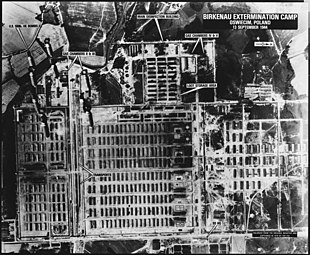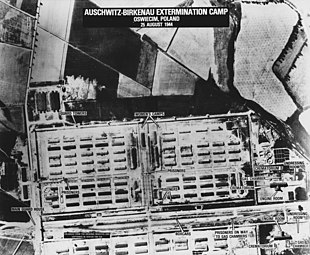
Auschwitz concentration camp ; also KL Auschwitz or KZ Auschwitz) was a complex of over 40 concentration and extermination camps operated by Nazi Germany in occupied Poland during World War II and the Holocaust. It consisted of Auschwitz I, the main camp (Stammlager) in Oświęcim; Auschwitz II-Birkenau, a concentration and extermination camp with gas chambers; Auschwitz III-Monowitz, a labour camp for the chemical conglomerate IG Farben; and dozens of subcamps. The camps became a major site of the Nazis' Final Solution to the Jewish question.

The Final Solution or the Final Solution to the Jewish Question was a Nazi plan for the genocide of individuals they defined as Jews during World War II. The "Final Solution to the Jewish question" was the official code name for the murder of all Jews within reach, which was not restricted to the European continent. This policy of deliberate and systematic genocide starting across German-occupied Europe was formulated in procedural and geopolitical terms by Nazi leadership in January 1942 at the Wannsee Conference held near Berlin, and culminated in the Holocaust, which saw the murder of 90% of Polish Jews, and two-thirds of the Jewish population of Europe. The Final Solution did not, however, include the hundreds of thousands of Jews killed by Romanian forces. By far the greatest extermination of Jews by non-German forces, this genocide was "operationally separate from the Nazi Final Solution".

Nazi Germany used six extermination camps, also called death camps, or killing centers, in Central Europe during World War II to systematically murder over 2.7 million people – mostly Jews – in the Holocaust. The victims of death camps were primarily murdered by gassing, either in permanent installations constructed for this specific purpose, or by means of gas vans. The six extermination camps were Chełmno, Belzec, Sobibor, Treblinka, Majdanek and Auschwitz-Birkenau. Extermination through labour was also used at the Auschwitz and Majdanek death camps. Millions were also murdered in concentration camps, in the Aktion T4, or directly on site.

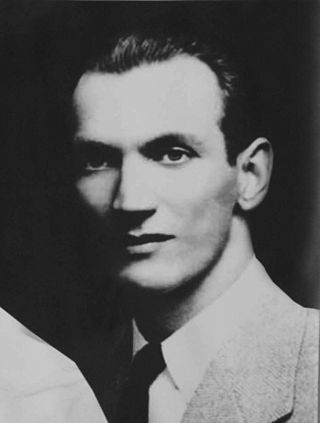
Jan Karski was a Polish soldier, resistance-fighter, and diplomat during World War II. He is known for having acted as a courier in 1940–1943 to the Polish government-in-exile and to Poland's Western Allies about the situation in German-occupied Poland. He reported about the state of Poland, its many competing resistance factions, and also about Germany's destruction of the Warsaw Ghetto and its operation of extermination camps on Polish soil that were murdering Jews, Poles, and others.

Alfréd Israel Wetzler, who wrote under the alias Jozef Lánik, was a Slovak Jewish writer. He is known for escaping from Auschwitz concentration camp and co-writing the Vrba-Wetzler Report, which helped halt the deportation of Jews from Hungary, saving up to 200,000 lives.

The terms "Polish death camp" and "Polish concentration camp" have been controversial as applied to the concentration camps and extermination camps established by Nazi Germany in German-occupied Poland. The terms have been criticized as misnomers. The terms have occasionally been used by politicians and news media in reference to the camps' geographic location in German-occupied Poland. However, Polish officials and organizations have objected to the terms as misleading, since they can be misconstrued as meaning "death camps set up by Poles" or "run by Poland". Some Polish politicians have portrayed inadvertent uses of the expression by foreigners as a deliberate disinformation campaign.

Sonderaktion1005, also called Aktion1005 or Enterdungsaktion, was a top-secret Nazi operation conducted from June 1942 to late 1944. The goal of the project was to hide or destroy any evidence of the mass murder that had taken place under Operation Reinhard, the attempted extermination of all Jews in the General Government occupied zone of Poland. Groups of Sonderkommando prisoners, officially called Leichenkommandos, were forced to exhume mass graves and burn the bodies; inmates were often put in chains to prevent them from escaping.

In the decades since the Holocaust, some national governments, international bodies and world leaders have been criticized for their failure to take appropriate action to save the millions of European Jews, Roma, and other victims of the Holocaust. Critics say that such intervention, particularly by the Allied governments, might have saved substantial numbers of people and could have been accomplished without the diversion of significant resources from the war effort.

The Polish resistance movement in World War II, with the Polish Home Army at its forefront covered both German and Soviet zones of occupation. The Polish resistance is notable among others for disrupting German supply lines to the Eastern Front, and providing intelligence reports to the British intelligence agencies. It was a part of the Polish Underground State.

The Auschwitz Protocols, also known as the Auschwitz Reports, and originally published as The Extermination Camps of Auschwitz and Birkenau, is a collection of three eyewitness accounts from 1943–1944 about the mass murder that was taking place inside the Auschwitz concentration camp in German-occupied Poland during the Second World War. The eyewitness accounts are individually known as the Vrba–Wetzler report, Polish Major's report, and Rosin-Mordowicz report.
The Vrba–Wetzler report is one of three documents that comprise what is known as the Auschwitz Protocols, otherwise known as the Auschwitz Report or the Auschwitz notebook. It is a 33-page eye-witness account of the Auschwitz concentration camp in German-occupied Poland during the Holocaust.
The Abandonment of the Jews: America and the Holocaust 1941–1945 is a 1984 nonfiction book by David S. Wyman, former Josiah DuBois professor of history at the University of Massachusetts Amherst. Wyman was the chairman of the David S. Wyman Institute for Holocaust Studies. The Abandonment of the Jews has been well received by most historians, and has won numerous prizes and widespread recognition, including a National Jewish Book Award, the Anisfield-Wolf Award, the Present Tense Literary Award, the Stuart Bernath Prize from the Society for Historians of American Foreign Relations, and the Theodore Saloutos Award of the Immigration History Society, and was nominated for the National Book Critics Circle Award."

Holocaust victims were people targeted by the government of Nazi Germany based on their ethnicity, religion, political beliefs, and/or sexual orientation. The institutionalized practice by the Nazis of singling out and persecuting people resulted in the Holocaust, which began with legalized social discrimination against specific groups, involuntary hospitalization, euthanasia, and forced sterilization of persons considered physically or mentally unfit for society. The vast majority of the Nazi regime's victims were Jews, Sinti-Roma peoples, and Slavs but victims also encompassed people identified as social outsiders in the Nazi worldview, such as homosexuals, and political enemies. Nazi persecution escalated during World War II and included: non-judicial incarceration, confiscation of property, forced labor, sexual slavery, death through overwork, human experimentation, undernourishment, and execution through a variety of methods. For specified groups like the Jews, genocide was the Nazis' primary goal.

Holocaust trains were railway transports run by the Deutsche Reichsbahn national railway system under the control of Nazi Germany and its allies, for the purpose of forcible deportation of the Jews, as well as other victims of the Holocaust, to the Nazi concentration, forced labour, and extermination camps.
Związek Organizacji Wojskowej, abbreviated ZOW, was an underground resistance organization formed by Witold Pilecki at Auschwitz concentration camp in 1940.

Leon Feiner was a Polish lawyer, an activist of the General Jewish Labour Bund in Poland and between November 1944 and January 1945 the director (prezes) and vice-chairman of the Council to Aid Jews "Żegota".
Zalman Gradowski or Chaim Zalman Gradowski originally from Suwałki, was a Polish Jewish prisoner of the Auschwitz-Birkenau concentration camp during the Holocaust in occupied Poland. On November 2, 1942, he was deported, as were all Jews then living in Lunna, as well as neighboring towns, to the Kielbasin (Kolbasino) transit camp. On December 5, 1942, he and all his Jewish townsfolk were forcibly marched from the Kielbasin transit camp to Lososno, Poland, where they boarded a train bound for, as he later discovered, Auschwitz. The train arrived in Auschwitz-Birkenau on the morning of December 8, 1942. After "selection" at Auschwitz-Birkenau, his family members as well as all women and children, and most of the men who were on the transport, were immediately sent to the gas chamber and murdered. Shortly afterward, Gradowski and several others from the transport who survived the “selection” were sent to work in crematoria as part of the Sonderkommando slave labour unit.

Raczyński's Note, dated December 10, 1942, and signed by Minister of Foreign Affairs Edward Raczyński, was the official diplomatic note from the government of Poland in exile regarding the extermination of the Jews in German-occupied Poland. Sent to the foreign ministers of the Allies, it was the first official report on the Holocaust to inform the Western public about these crimes. It identified Treblinka, Bełżec and Sobibór by name as extermination camps. It was also the first official speech of one of the governments of Nazi-occupied Europe in defense of all Jews persecuted by Germany – not only citizens of their country.
